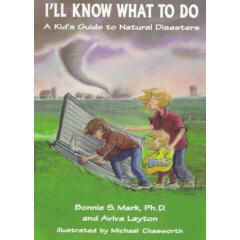|
Empowering Children
How Do We Teach Empowerment?
The primary way
anything is taught to
children is through modeling. From the time they are infants, they
are watching us and mimicking us. They learn as much from what we do
as what we say. And if there is a
Therefore, the most effective way to teach children they have the power to take positive action -- to work through the challenges before them (now and later in life), is to encourage this belief in ourselves, and to make choices -- take action -- that reflects this belief.
Don't Fake It On the other hand, if we fake and bluster -- if we pretend to have such a belief in ourselves when in fact we do not -- they will see through that also. And they may learn that people should be frauds, that our authentic selves are not enough. Or worse yet, that empowerment is impossible -- that our words (our spoken messages) are only empty rhetoric. Instead, we must simply do our earnest best, as honestly as we can. If children see us standing fast in the face of our own doubts, if they see us overcoming obstacles despite our own handicaps and weaknesses, then they will have the chance to conclude, "Perhaps I too can do it, despite my doubts, and despite my weaknesses." It is our process they learn from, as much as our words.
Other Role Models We Can Give Not only can we set an example through our own acts, our own process, we can also share the experiences of others -- people young and old, human and non-human. For young children, picture book characters can provide very accessible role models (both visually and emotionally). Such stories such as , "The Little Engine That Could" model the importance of positive thinking -- the old train in the story, for example, that said "I cannot" talked himself right out of trying! Remember that with young children we must avoid the temptation to be too wordy or to talk over their heads. Neither should we condescend. But rather, we must make whatever we are teaching relevant to the child -- to what he or she already knows, sees, feels, and cares about.
Remember to pull out the most important nugget of the story to share with your child, and elaborate only if your child indicates a desire to know more. (This will keep you from appearing as a long-winded lecturer out to enlighten the less knowledgeable.) Storytelling is a valuable tool also. This is where you draw on incidents in your own life to create an orally-transmitted story (or you could write it down!). Many people are naturally great story-tellers! If you are not one of them, you might find a workshop in your community to help hone your skills.
Developmentally Appropriate Environments & Challenges While I have talked about the importance of role models and of consistency between word and deed, let's not forget that children also learn by doing. They observe and then they do -- playacting at what they have seen. Conversely, like small scientists, children also do.. and then observe the results of their actions. We must ensure that children have sufficient opportunity to playact and to explore. Too often children are rushed from here to there and back again -- and kept busy with highly organized, goal-oriented activities in between -- that they have no time to indulge either of these vital, natural drives. Children must be given time to dream, to touch, to feel, and most of all to construct. To build their ideas, to expand on their questions, and to develop a deep sense of rootedness, of connectedness (physically and emotionally) to the world around them. Besides time to explore and pretend, children need permission. As caregivers and teachers, we will do much to empower children if we take care to present them with environments (home, classroom, etc.) that are enriching, safe and child-friendly. Although it is important to give kids opportunities to learn about limits, we want to avoid creating environments where we must constantly spout negative remarks, "Don't touch", "Don't do that," "Stop it", "Sit still", and "Let me do that for you." Instead, we would like to have many opportunities to say "go ahead, see how that feels", "try it and see what happens", "see how much you can do". But this requires thinking ahead and knowing what is developmentally age appropriate. Finally, just as we don't want to over-constrain children, we also don't want to be overly permissive. That is, we don't want to set them up for failure by setting them loose in situations or environments where they are likely to cause damage or be injured. Instead, we provide them with settings that are safe and child-friendly. And when we introduce them to situations where there must be stricter boundaries ("Please, don't touch anything."), we keep in mind the limits already imposed on them by their age and stage of development. We obviously don't expect a 14 month old to have the same self-restraint as a 10 year old. And we don't expect a 10 year old to stay amused and contented by the same activities and range of freedom that enthrall the 14 month old. And finally, we don't expect ourselves as parents and educators to stay blissfully calm while either one repeatedly vents their frustration at being pushed beyond their limits. We plan ahead with reasonable, informed expectations.... and then we do the best we can with whatever comes up. (Note: many of us have found that a spiritual practice helps in this.)
Encourage Healthy Boundaries Yet another way to help to help children positively experience and discover their personal power is to teach them about healthy boundaries. Specifically, we can encourage children to speak their minds, to share what they really feel -- in ways that respect the rights and feelings of others. We can encourage them to speak up for what they need and what they believe in. And validate them when they do. You might tell your vegetarian child, "I noticed that you told Grandma you didn't want to eat the turkey. You weren't afraid to say what you really felt. And I'm sure Grandma appreciated your saying it in a kind way." With a four year old student at preschool you might say, "Good using your words. You really told Magda how you felt about that. You didn't want her to take your ball!" Remember however, that listening is a vital part of this process. Sometimes you will be the one a child must speak up to. If you can really listen, and communicate back what you think you have heard, you will not only make that child feel more valuable and powerful, but you will also improve your relationship with that child.
Risk Taking and Self-Nurturing We can also validate children simply for trying, for taking risks. Taking action is a primary component of personal power. And the fear of making mistakes, is its chief disabler. It's important to comment on the attempt children make-- not just the success. Children also benefit from being validated for being true to themselves and for nurturing themselves (knowing when it's okay to choose not to take a risk). Knowing your limits is critical. We set ourselves up for failure when we don't take notice of the small voice that says "I've had enough for right now." We can encourage them as they engage in the process of learning to do all this better, of constructing knowledge on how to do it effectively .
In Conclusion Modeling our own process; sharing the stories of others who kept faith in their own (and others') positive potential; providing safe, stimulating, and developmentally appropriate environments and challenges; teaching healthy boundaries; and validating children for trying, for taking healthy risks, and for listening to their inner truth are all ways that we can empower children. For more information about child development and some of the other topics touched on here, please browse around this website. If you can't find what you are looking for (through either articles like the one above, linked information on other sites, or through books or organizations listed on this site) please drop us an email and we'll do our best to point you in the right direction.
How do we create positive change? It must begin with the belief "I can -- step by step, bit by bit -- I can." And when our faith in the power of "I" is a bit shaky, we must develop the belief in something bigger than ourselves. If not a spiritual "something", then in the power of community. We must know, that we are not alone. That working together "we can". ("Si, se puedes" as the song goes.) We must remind ourselves that, "there is a way." In this way, our mind is open to the seeds of possibility as they arise. Making positive change in the world (even in our private world) is not so much about forcing our will, as it is to opening up to a possibility. Allowing it a space to come in, to enter our lives, our world. We must consider that when something truly needs to be done, the way to do it not only can open to us, but will open to us. For many people, this seems a ridiculous supposition, not at all in keeping with the way we've been told the world works. After all, we've all experienced setbacks. And it wouldn't be hard to point to incidences in our personal lives when we've wanted something and we didn't get it. And yet, that perspective only takes into account the desire of the personality self alone. What about the desire of the soul self? Or even, of the unconscious aspects of the self? When the desires of the personality self are in conflict with its own deeper fears and desires and wisdom, the will is diluted. The ability to affect change in the world is dampened. So, when the way does not open, perhaps it is because we are not willing to see it. Sometimes we look away -- out of fear of the unknown, out of lack of self love, out of the belief that we simply cannot escape our suffering, and so on. (But perhaps it would be better to ask ourselves why we believe these things, than to simply accept that they reflect an inevitable reality!)
So many of us were taught to believe that to do great things, one must use great force -- great force of will, a great force of intelligence, great force of power, or wealth or influence. That this was why good things happened for some people and not for others. And we said in response, "What about the rest of us? I have none of these things -- or if I have some of it, there is so much weighing against it. "I can only do small things. I don't have the energy, the experience, the drive, the time to do great things -- or even to keep up with all the commitments of my present daily life." But what if it were enough, to do one simple thing at a time? What if something greater than our conscious mind could provide the vision, the motivation, the desire, and the influence. What if all we had do was sit down and ask what is in our own hearts. And then, having uncovered this, to ask... for a way to make it come about? The dream is there, inside us. It is not something we must think up, wholly by the efforts of our rational selves. And it is not simply our base desires, heretofore repressed. (Although both of these are a part of ourselves, and therefore should be given a respectful hearing.)
The dream is there, unfolding in concert with these other aspects of
ourselves, these other needs and creativities. How To Tap Into It
|
|
|
Check out our great
Earth's
Kids
Kids
Can Change the World
action pages and Valentine's Day, Easter and Saint Patrick's Day pages for science and craft activities, reading and more!
Every
day is
EARTH
DAY!
Check
out our great fun
activities, art, & learning Wondering about the weather? Don't miss the Earth's Kids special feature on Climate Change & Global Warming!
Learn how to keep your
children safe in the event of a natural disaster. Tips to Teach Kids How to Wash Hands!
|
Copyright Earth's Kids 1999. All rights reserved.











